Hospitals of Tooting
View all Close all
I have included this hospital even though it is not in Tooting as my aunt who lived in Tooting spent time in there as a patient and a neighbour of mine who lived in my road in Tooting also spent time in there firstly as a patient and then for rehabilitation before coming home, she was elderly and there was a part in the hospital set up like a bedsit to see if they could look after themselves (i.. making tea) before being sent home.
It was a Vicar Canon John Erskine of St. Mary’s Church Battersea that instigated the establishment of a voluntary hospital in his area. Bolingbroke House was purchased in 1876, this was an old red brick 3 storey mansion in Five Houses Lane which eventually became Bolingbroke Grove. It was purchased for £4,500.
The house was for outpatients only, it had a resident doctor and a provident dispensary, this was until enough money was raised to open wards, the house could accommodate 50 in patients due to its size.
In 1880 the House of Sickness and Self-Supporting Bolingbroke Hospital was opened and this became a small general hospital with an accident and emergency department with 30 beds. The poor had to receive medical care in workhouse infirmaries while the rich received medical care at home, middle class people did not want to go to the workhouse infirmaries but they could not afford private care so this hospital was one of the first to cater for middle classes. For people who could not afford to pay medical fees these hospitals began to be established by the late 19th century. As this was a voluntary hospital, they could not treat the incurable, mentally ill, epileptics and maternity cases, these types of patients were not eligible to be admitted.
There was a ward opened in 1893 especially for accident cases where the casualties could receive free treatment. There were plans drawn up for the complete demolition of Bolingbroke House and the rebuilding of the hospital by the end of the 19th century.
In 1901 the first phase was completed, at the northeastern end of the site they extended with a single storey wing in Wakehurt Road, this housed the outpatient department, as Queen Victoria had recently died it was called the Victoria memorial Wing.
In 1906 the second phase began another wing was to be added to the north of Bolingbroke House and the foundation stone was laid by Princess Louise, this contained an operating theatre, wards and a mortuary, it was called Canon Erskine Clark Wing, the flat roof was used as a place for patients and staff to the the air, the three storey building also had a basement.
Just before the outbreak of WW1, the Bolingbroke Wing was added in 1914, another three storey building. The Third London Hospital transferred patients to Bolingbroke and 20 beds were kept in this wing for military cases. This number was increased to 25 by 1917, a prefabricated x-ray room was also bullt which was later converted to a chapel.
Princess Mary, Viscountess Lascelles laid a foundation stone in 1925 for the new William Shepherd Memorial Wing which was completed in 1927, this was named after a “philanthropically minded builder”, there were two wing parts divided by an imposing stair tower. There was an 18 bed ward in the southern part, there were single rooms for private patients on the first and second floors with a 4 bedded ward, there was also a corridor that connected this wing to the Canon Erskine Clarke wing.
On the first floor of the Shepherd wing there was a children’s ward including 20 cold, this was called the Anne Carmichael Children’s ward and had tiles decorating it showing animals and nursery rhymes.
The weekly charge for a private room in 1928 was 6 guineas (£6.30) or 4 guineas (£4.20) if the patient was in a 5 needed ward. The fee included board and lodging, medicine, care from nurses and the Resident Medical Officer, surgical dressings, use of the operating theatre and certain stimulants. The patient paid extra if they wanted laundry, pathology, x-ray, massage or a special nurse, they paid for the attending clinical separately. For an inpatient in 1928 the average cost was £2.13s 6d (£2.66) compared to the 1927 cost of £3.13s. 6d. (£3.67), an average length of stars was 17 days.
Due to the addition of new wings, Bolingbroke House became hemmed in on three sides, the front faced the back of the Shepherd Wing. Work began on building the new Central administration block in 1937 when the old mansion was demolished, this unified the frontage on Lakehurst Road and created a new main entrance to the hospital, a War Memorial was included for the fallen of Battersea during WW1, this scheme was provided for by The Battersea War Memorial Committee.
The new entrance lobby comprised a vestibule with reception booth, was lined with marble, the hall was octagonal and made into a hall of remembrance. Various board rooms and offices ran off three corridors as well as the Board Room. There were 6 bedded wards on the first floor and on the second floor there was accommodation for nursing staff, the main kitchen was on the top floor. In 1930 there was a new mortuary build with more storerooms. By 1938 it cost an average of £3. 8s. 2d (£3.41) per week per patient.
It was affiliated with St. Thomas’s Hospital and joined the Emergency Medical Service at the outbreak of WW2, in 1941 it received bomb damage and in 1944 it was hit by a V1 flying bomb.
Due to a lack of Deep cleaning of the wards and accommodation for nursing staff, in 1946 there were only 118 of the 135 beds open. The average cost of a weekly tay was £7 6s. 7d (£7.33) compared to £6 9s 7d (£6.48) in 1945 and the average stay was 22 days. X-Ray equipment was installed in the same year used for radiation treatment of certain disorders of the skin.
In 1948 the hospital with 135 beds joined the NHS despite misgivings from the hospital board. It became part of the South West Metropolitan Management Committee Regional Hospital Board under the control of the Battersea and Putney Group Management Committee.In 1953 for Coronation day, a local radio and electrical engineer r. K M. Hubbard loaned 20 TV sets to the Hospital for patients to watch the ceremony. Work had begun by this time on a new wing, the cost of each patients care was £16 4s 4d (£16.22) per week between 1953 and 1954.
Sir Zachary Cope opened a new X-Ray department in February 1957, he was a former surgeon in the hospital. The new department was situated in a new single storey block costing £35,000. The new block was perpendicular to the main building, the hope was that in future new floors would be added for a new wing. Overhead lights were installed over each bed in the same year in the last two wards, this meant patients could control their own lighting. A chapel was installed in part of the old X-Ray department at a cost of £2,000. A dedication service was held upon completion on 21st September 1957 by the Rt. Revd. W. P. Gilpin, Bishop of Kingston. There were 129 beds in 1959. In 1967 a new Coronary Care unit was opened, in 1972 it was enlarged with more beds as Convalescent coronary care beds.
After a major reorganisation of the NHS in 1974, the hospital was part of the South West Thames Regional Health Authority under the care of Merton, Sutton and Wandsworth Area Health Authority. The Accident and Emergency department closed in 1974 despite protests from the local population. Because of low bed occupancy the option was mooted of completely closing the hospital.
The hospital began to focus on services for older people in the 1980s and by 1989 there were five wards for acute admissions, rehabilitation and treatment, a Day Hospital and six beds for respite care. As elderly patients were housed on the upper floors, there rose the issue of fire safety. The buildings were deteriorating but there was no remedial action taken then.
The hospital became part of the newly formed St. George’s Healthcare NHS Trust in 1993 following the introduction of the ‘marketplace’ system in the NHS.
The question of fire safety was reviewed in 2004, they sought advice from the London Fire Brigade. In 2005 based on the independent fire safety report the trust decided to close the remaining 54 beds. The remaining in-patients were transferred to community hospitals or nearby nursing homes despite refurbishing the wards the previous year at a cost of £2.5m.
Bolingbroke became a community hospital, it had various health care services, out-patient clinics and a day hospital for 15 elderly patients. Wandsworth Primary Care Trust which funded the services and St. George’s Healthcare which owned the site jointly agreed that as the hospital was 80% empty and running down it was proposed to remove the facilities to St. John’s Hill to the new St. John’s Therapy Centre, less than 1 mile away.
The local community was opposed to the closure and councillors from Wandsworth managed to block the plan. In 2007 Alan Johnson who was Secretary for Health agreed to closing Bolingbroke Hospital and transferring services to St. Johns after the matter was referred to him.
Source: https://ezitis.myzen.co.uk/bolingbroke.html
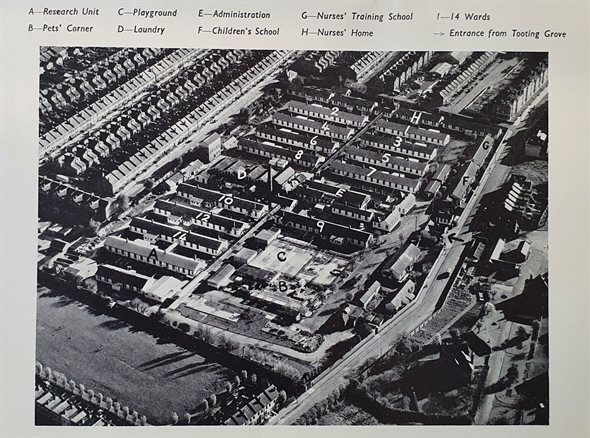
In 1867 the Metropolitan Asylums Board was set up to administer care for certain categories of poor sick people in Metropolitan London. In 1890 they chose Tooting for the location for one of the new phase of hospitals to be erected by them.
They expanded the new hospital to include provisions for fever and infectious diseases for the inhabitants of the capital. There was a violent outbreak of Scarlet fever the following year, this swamped the Metropolitan asylum Boards’ hospitals so a temporary new hospital was set up in Tottenham and was opened in October 1892, due to a resurgence of Scarlet fever more accommodation was needed so to provide this a ten-acre site in Tooting was acquired for £4,395, a new 400 bed hospital was erected and fitted out in nine weeks, named The Fountain and designed by Thomas W. Aldwinckle.
These buildings were mostly timber framed, single storey standing to floor level on dwarf brick walls. On the exterior they were covered with corrugated iron, felt and boarding. The insides were lined with asbestos on plaster with boarding.
There wads a porters lodge on the west side of the entrance which was on Tooting Grove, it had a lavatory, waiting room and contained a gate office, there were bathrooms and discharging rooms at the rear. These had separate entrances on each side, on the receiving wards was the “infected” one and the stores and administrative building had the “non-infected” one.
There was an administrative building in the centre of the site running from south-west to north-west, this had a laundry room and boiler house to the rear.
On each side were eight ward blocks, these were arranged in two rows each had four which had a covered way to link them. There were 24 beds in each block, there was also a staff WC with a bedroom for an attendant, a scullery, bathroom for the patients and a linen room. On the north-west edge of the site were a further two isolation blocks, these temporary blocks were still in use in the 1930’s.
South-east of the site were four blocks , these were for accommodation for the different classes of the nursing staff, there was a recreation room attached. Further along the south-western perimeter were huts housing the female domestic staff and the male servants were housed on the north side of the lodge. In the western corner were the mortuary and workshops.
The hospital was redesigned in 1911 to a mental hospital, the lowest grade of severely "subnormal" children were housed there.
The London County Council took over the administration of the hospital in 1930, it was retained as a hospital for the "mentally defective" children. In 1960 the hospital was demolished and the new St. Georges Hospital took over as the new occupant.
Source: https://www.workhouses.org.uk/MAB-Fountain/
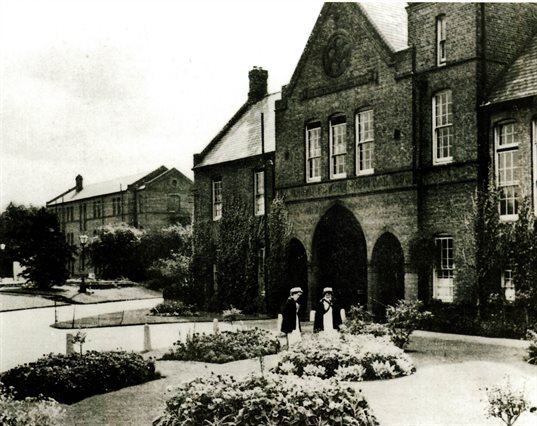
This hospital’s commissioned in 1893, it was opened as the Grove Fever Hospital in 1899 in Tooting Grove.
It was annexed to the Fountain Fever Hospital originally but converted to become a mental hospital for children in 1913.
It became the Grove Military Hospital in 1916 and in 1920 reverted to the Fever Hospital again. A discovery made in 1932 by Joseph Bramhall Ellison was reducing the mortality rate in children with Measles by giving them Vitamin A. In 1948 it joined the NHS and in 1958 became St. Georges Hospital Tooting Branch as the Main St. Georges Hospital was at Hyde Park Corner.
In 1973 it was demolished to build the new St. Georges Hospital that stands there today.
I was a patient there in my teens, I remember being wheeled from the ambulance down an open sided covered corridor to A & E, then I spent a few days in a long ward, it was still the old hospital when I was a patient.
Source: https://www.workhouses.org.uk/MAB-Grove/
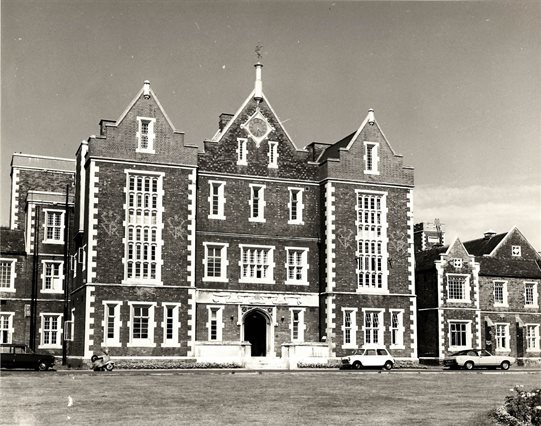
The building of public asylums was encouraged by the Asylum Act 1808, because counties were very slow to react, only nine asylums were build by 1827, this meant that mentally ill people were still living in private madhouses, in workhouses and on the streets.
Finally in 1838 the magistrates in Surrey decided to establish a county asylum, this was for the poor mentally ill people. Springfield Park was purchased for £8,985, from a wealthy land owner who lived from 1779 until 1855. He was part of the firm Barclay-Perkins and a brewer, he decided to move to Dover and his land was ideal.
The estate had 97 acres of land, because it was near to population centres it was the ideal place for an asylum, it had a suitable water supply, clean air with a southerly aspect. There was an 18th century mansion house, coach house and stables the site as well as farm buildings. A well was bored and the entrance was in Aboyne Road.
The construction was completed by 1840, this was the 15th Asylum to be built, it had 350 beds, cost £67,467 to build with an extra cost of £7,515 for initial expenses and furnishings. It was built on the corridor plan, this has a long spinal corridor at right angles with ward wings radiating off from it. The patients were sent to designated wards after being diagnosed and classified.
The Tudor style was used to build the asylum with twisted chimneys similar to those at Hampton Court, after being considered dangerous later they were removed and not replaced. There are variegated brickwork patterns with subtle angles on the outside facade but inside apart from the main hall and staircase was very dull and plain. The central heating was hot air injected through the floors with steam circulating through the galleries. There is a stone carved fountain with large sweeping lawns that flank the reception area. The committee room was on the right as you enter the main building and on the left was the residence of the medical superintendent. On the 2nd floor of the central part the steward was housed, upon his retirement in 1872 his rooms were given over to nurses and domestics as their accommodation. There were two offices behind the main hall, these were used as surgeries for medical staff to write up their notes in huge bound volumes. At the rear of the building were the boiler house, the gas works and kitchen and from 1881 a builders yard.
The asylum opened on 14th June 1841 after staff were hired, it was known as the Surrey County Lunatic Asylum. On the first day 299 patients were admitted from asylums in Surrey and London, 172 were from Peckham House, 54 were from Hoxton and 51 from Bethnal Green. There were four principle officers in the new asylum, a Resident Medical Superintendent with a salary of £250 a year, a visiting physician, a Matron with a salary of £80 a year and a steward with a salary of £150 a year. The nurses then were called attendants, they earned £26 a year and the weekly cost of keeping an in patient was 9s (now 45p).
At the end of the first year there were 385 in patients in the asylum, 215 females and 170 males, by the end of that period there were still several elements missing for the proper functioning of the asylum. The porters lodge was still not built and the front drive Had not been made.
£1,981 was spent in 1842 to level the ground moving the evacuated earth. There were new roads that were laid and gravelled. They turfed the ward gardens called airing courts where the patients exercised and for patients recreation a bowling green was laid down. To mark the boundary of the Asylum an oak fence was erected. It cost £1,574 to build a Wall round the kitchen garden, this enclosed 8 acres of the northeast of the site. For occupational therapy for the male patients, they reused the farm buildings west of the asylum.
The pipes used for the central heating system proved to be too thin, there were explosions throughout out different wards resulting in injuries to patients. Fireplaces were installed instead and the central heating system was removed.
The asylum became overcrowded after five or six years, in 1849 at a cost of £35,000 it was extended and two new wings were added, this provided 400 more beds.
In 1850 the water supply ran out so a new well had to be drilled, while this was being drilled the asylum was supplied by the Lambeth Waterworks Co at a rate of not fewer than 30,000 gallons per day, the cost was 3d (Just over 1p) per 1,000 gallon, the new well was operational in 1860.
The asylum could accommodate 534 females and 430 males by 1855, Dr. Hugh Welch Diamond (1807-1886) was the superintendent of the female department from 1849-1858, he took photos of his patients that were of exceptional quality and he was described as “father of psychiatric photography”.
Additional land was acquired east of the site in 1860 and 1864, then the asylum had 14 acres of kitchen garden, 83 acres of farmland so male patients were employed to provide the food for the institution. The asylum was almost self sufficient as were other asylums at that time.
To treat patients with infectious diseases, in 1881 a separate cottage hospital known as White Lodge was built. The patients built it at a cost of £9055 and it was designed by the medical superintendent. A ballroom was built in 1879, as the amount of patients increased two further wings were added at the south of the site.
A purpose built chapel was built in 1881 to replace the one in the main building, this was in accordance with the wishes of the lunacy commissioners. In 1885 a water tower was built, this was an attempt to solve water supplies from the two wells, it cost £1,300 and was demolished in 1976. The pump from the original well was used until after World War Two, it was a Maudsley table engine and it is now in the Science museum, The other newer pump used in the second well was broken up for scrap.
London County Council and Middlesex County Council were formed in 1899 following the Local Government act 1888. The asylum was renamed Wandsworth County Council.
A new entrance was made in Glenburnie Road in 1893, this made the Asylum back to front. New accommodation was built for the Superintendent and his family as well as a new lodge by the new entrance. These new buildings were lit by electricity from the first, an extra lodge was built in 1897.
"Mentally handicapped" children were kept apart from mentally ill adults under the Lunacy act 1890, an annex for "idiot" children was opened in 1897 with 260 beds in a separate building. The Medical Superintendent Dr. Hugh Gardiner-Hill (1856-1925) advocated this. At the front of the building were located toilets and visiting rooms, at the rear of the building were the wards, visitors were not allowed in that area.
During the first world war the asylum became Springfield War Hospital. In the annexe a Neurological Unit was established, this was for "idiot" children and named Springfield House Hospital, a high fence separated it from the main hospital for the patients with loss of mental balance or shell shock.
This was the principle reception centre along with 4th London General Hospital for the mentally disabled from the front in France. Protracted or severe cases from the Neurological units of the 23 Territorial Force General Hospitals were referred to Springfield House Hospital in 1916. Following the Mental Treatment act of 1930, the annexe was never used again after the war for "mentally handicapped" patients. It was renamed the Admissions Hospital and was used for Voluntary patients.
In 1927 the Wandsworth Asylum became Springfield Mental Hospital, there was an association formed with the Medical School and Westminster Hospital. In the outpatients clinics in Springfield clinicians taught medical students while consultants at Westminster Hospital provided a service to Springfield patients, this was an arrangement that lasted until after World War Two.
Accommodation for 140 nurses was officially opened by Princess Mary Countess of Harewood in 1930, the nurses were previously housed in the towers and side rooms of the main building.
An infirmary block (now the dispensary) was opened in 1931 to treat patients who were mentally ill as well as physically ill. Operating theatres were installed in the block and there were 1,848 patients by 1932.
An annexe was opened in Kingston Road in 1933 to accommodate elderly female patients.
By 1939 there were 1,931 patients and the name had dropped the work Mental so it was Springfield Hospital.
Basement were used during the second world war to shelter patients as there were no bomb shelters available. Hundreds of patients were affected by a breakout of Dysentery. A new strain was discovered as well as Sonne forms and Flexner forms. The Annual report states Springfield Hospital had the distinction of developing a new infective agent. The bacillus dysenteriae Springfield is unlike any other bacteria of the intestinal group.
The breakout of this new disease produced a legacy of carriers of the disease, these carriers required segregation from the other population of the asylum. There was blast damage to the buildings from nearby flying bombs although they did not suffer any bomb damage. By the end of 1945 the Hospital had 2,040 patients.
In 1948 the Hospital joined the NHS with 1,856 beds, it was under the control of the Springfield Tooting Hospital Management Committee providing usual treatments for mental illness, deep insulin treatment, Cardiazol Convulsion therapy, electroplexy (ECT) as well as neurosurgery. There were outpatients clinics at West Middlesex, St Charles and Westminster Hospitals.
As happens with mental hospitals elsewhere, there was an increase in the ratio of elderly patients. There was shortage of nursing staff in 1949 and the hospital was overcrowded. There were 2,128 patients, 1,388 females and 740 males and 33% of those patients were over 65. These patients were moribund, senile or disturbed but were not in need of psychiatric care, they just had nowhere else to go.
In 1950 repairs of the wards began together with modernisation of the hospital, there were 2,153 patients at that time. Some of the buildings were underpinned, the kitchens had new refrigerators installed. Wards were renamed and the letter and number system previously used for wards was abandoned. They used names of trees for male wards, examples were Elm, Willow and Yew, Flowers were used for female wards, examples were Zinnia, Fuchsia and Aster, and for the seriously disturbed there were Teak and Fir wards. The old cottage hospital became White Lodge and was refurbished with radio and TV, this was for neurotic female patients, the male neurotic patients had their own ward in the admissions building. They changed the house for the medical superintendent to a hostel for male nurses.
There were 50 cows on the farm, these produced 800 gallons of mile per week, there was poultry for producing eggs and providing meat as well as pigs to provide meat. There was an orchard producing fruit and in 1951 2 acres of the farm were lost for a school playing ground to be created.
The average stay of a patient was 1,050 days in the early 1950s so in 1953 they built an annexe in New Malden for 290 elderly female patients who required custodial care for a long period. There were TVs set up in. Wards for the patients to watch the Queen’s coronation in 1953 with the sisters being given a 12 inch TV for their sitting room. There were 1,364 female patients and 764 male patients totalling 2,128 staying an average of 779 days and during that time there were occurrences of dysentery most on an annual basis in the annexe and main building.
There was a perpetual shortage of staff in the hospital by 1954, with 40 part time female nurses, 110 full time female nurses, 7 part time male nurses and 120 full time male nurses all looking after 2,089 patients. There were 21% of patients over 65 and 250 voluntary patients. For an in patient the cost was 17s 6d (88p) a week. There was an arrangement between Springfield and St. James Hospitals for patients who needed general surgery to be sent there, the arrangement was with Whittington Hospital if it was Neurosurgery as the post of Neurosurgeon at Springfield was vacant. A new centralised radio system was installed in the wards and the King Edward’s Hospital fund gave £7,000 for a new occupational therapy centre for 200 patients. It was to be build with equal distance to the Cottage Hospital, the Admissions Hospital and the main block.
The chapel could only house 32 and they usually had to squeeze 45 in so in 1954 the chapel was altered to double its capacity as the hospital had some 250 Catholic patients.
In 1954 the LCC took over 26 acres of land due to the extinction of the farm, this was used to build a housing estate and a new school. They kept the poultry and piggeries and these were tended by the male patients, 40 of these patients also worked in the orchards and gardens.
There was a new occupational therapy centre opened by Dr. Noel Harris in 1955, he was the past president of the Royal Medico-Psychological Association, there were 2,093 patients by then and 16.9% were over 65. By this time the hospital had entered the age of tranquillisers, there was the advent of Largactil (Chlorpromazine) and this led to the reduction Deep insulin treatments being reduced. In the King Edward Memorial Hospital in Ealing two out-patient clinics were established.
In 1955 the farm gate was discontinued as all dairy farming had ceased, part of this land I now the site of Burntwood School, the Ice House from the Springfield Farm which is now Grade 11 listed still remain s on the site. The other part of the farm became the Central London Golf Centre (formerly Springfield Park Golf Course). The male nurses moved to the nurses home from the Medical Superintendent's house and there were internal redecorations done in the admissions hospital. There were 34 dysentery patients that were housed in one ward and there were 14 enteric carriers.
There were 2,069 patients in 1956, 21% of these were over 65, there was a high death rate of 10.94% of patients but as there were so many elderly patients a lot died of respiratory conditions that afflict old age.
By 1950 urban development surrounded the hospital, the number of in patients began to fall during the 1960s mainly due to the introduction of drug treatments so many patients could be treated at outpatient clinics. We presume that Burntwood Villa built in 1960 and Springfield Cottages built in 1968 both in the northwest corner of the site were for staff residences.
Following a major reorganisation of the NHS, in 1974 Springfield came under the South West Thames Regional Health Authority as part of the Wandsworth and East Merton (Teaching) District Health Authority, there were 1,124 beds in 1978.
There were 1,000 beds in 1980 and after another reorganisation it became part of the Wandsworth District Health Authority in 1984 then there were 828 beds. A centre was built and named after Joan Bicknell the first professor of the psychiatry Mental Handicap, this lady was a pioneer of psychodynamic thinking working with people with learning disabilities.
Large mental institutions were being closed in the beginning of the 1990s due to a new attitude to mental health issues. If not closed they were gradually being emptied. In 1986 a report was published “Making a Reality of Community Care Act” and following this there was a government policy of returning patients to care in the community. Patients were able to receive long-term care in their own homes following the National Health Service Community Care Acct 1990, they had adequate support in a residential home setting.
In 1991 the Morris Markowe Unit in New Malden closed and a nursing home for 56 residents called Ronald Gibson House was opened on the hospital campus in the same year, in 2006 it was extended.
There were fewer patients admitted throughout the 1990s so wards were closed. This meant an increase of out patient clinics and services. Springfield became part of the Pathfinder Mental Health Services NHS Trust in 1994 and following this in 1998 changed to the South West London and St. George’s Mental Health NHS Trust.
The £&million Phoenix Unit owned in September 2005, this is a 2 storey low secure mental health rehabilitation facility with accommodation for 18 patients. In April 2009 the latest £23 million Wandsworth Acute Unit opened, this contains a 10 bed psychiatric intensive care unit and an 18 bed acute ward. In 2010 the site was the Headquarters of the trust, most of the buildings were disused and there was hope to sell off most of the site for redevelopment.
The old buildings would become 262 apartments, new family housing would be built and this residential area would be known as Springfield Village.
New mental health facilities were to be built in the northern part of the sprawling campus.
The main building built in 1840 is currently on the English Heritage’s “At Risk” register and has Grade 11 listed status as does the Elizabeth Newton Wing which was built in 1897.
The chapel became the Mayfield Gymnastics Club and the mortuary which is now called Island House was converted into an exhibition centre.
Planning permission to redevelop the site was refused in December 2010 but an update shown in 2013 said planning permission has been granted in June 2012, the project is now called Springfield Park.
Source: https://ezitis.myzen.co.uk/springfield.html
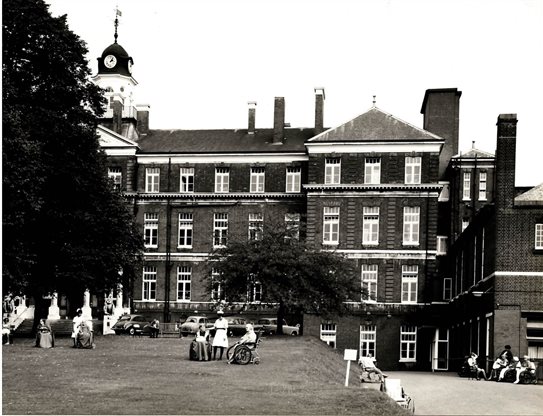
The Wandsworth Board of Guardians took over the former St. Joseph’s Roman Catholic College in 1897 to provide extra workhouse accommodation. The original manor house was called Hill House was bought by St. Joseph’s teaching brotherhood and they built the college on the site where Hill House was in 1887 it was opened as a Roman Catholic school. As the upkeep of the school proved too expensive, it moved to Beulah Hill in 1895 that is when the guardians bought the site for £40,000 spending another £30,000 making alterations to the three storey college building. It was renamed the Tooting Home for the aged and infirm, and Hill House became a nurses home, this was once the home of the author Daniel Defoe.
The committee room and various administrative offices were on the ground floor together with apartments for the Master and Matron. There were also smaller wards containing only 7 beds, a few single rooms used to accommodate nurses and two large 42 bed wards. On the first floor were located more wards as well as day rooms for patients for recreation, every ward was named after a Wandsworth guardian.
Every bed had a mattress with wire springs that had hair overlayed, a flock bolster with a pillow of feathers, a white counterpane and three blankets. There was also a chair beside each bed which was comfortable for the patient.
In the kitchen there were three large coppers( there were cauldrons for heating water) and a cooking range. The kitchen, scullery, pantry and storerooms were all located in the basement, also in the basement were staff dormitories, a needle room and a storeroom for clothes.
There were 605 inmates by 1901 and eight temporary buildings all single storey were erected in 1903 to house another 102 females and 102 males, these were located at the northeast of the site. These buildings ran parallel to Church Lane and were either side of a corridor that linked them.
The War Office took over the building during WW1, it cache down as Church Lane Military Hospital as well as being known as Tooting Military Hospital. It was for enlisted servicemen and had 712 beds which included 40 beds used for dysentery cases, 26 for eye patients and 60 for TB patients.
It was used as a neurological hospital after the war by the Ministry of Pensions for shell-shocked and neurasthenic ex-servicemen up until 1923.
It was left empty and derelict until 1930 when the site was bought by the LCC, they spent £30,000 on renovating and re-equiping the hospital to be used for long-stay patients.
It was renamed St. Benedict’s Hospital when it reopened ib 1931, it was used for three classes of patient. Those that needed rehabilitation or convalescents. The aged chronic sick and young adults that were incapable permanently.
In 1938 a lot of the activity at the hospital was reduced, rehabilitation patients were sent to Margate, only two classes of chronic patients were then being admitted. In 1948 the hospital joined the NHS, by then it had 200 patients and was part of the South West Metropolitan Regional Hospital Board under the control of Wandsworth Hospital Management Committee. The X-Ray department was improved and a new chapel was built between 1948 and 1950.
There were 246 beds in 1950 and a further 50 beds added by 1951, the extra beds were for male patients undergoing rehabilitation and for fracture cases from St. James’ Hospital in Balham as it was at that time undergoing major rebuilding.
In 1974 following the reorganising of the NHS, Wandsworth and East Merton (Teaching) District Health Authority took over control these were part of the South West Thames Regional Health Authority. Sadly the hospital was closed in 1981.
This was a lovely building which has been demolished, all that remains of the building are the Hospital Buildings entrance gateway with the post in Church Lane, also the main block’s portico and the close tower that have been preserved in the grounds of the new modern development which is a housing estate.
Source: https://ezitis.myzen.co.uk/stbenedicts.html
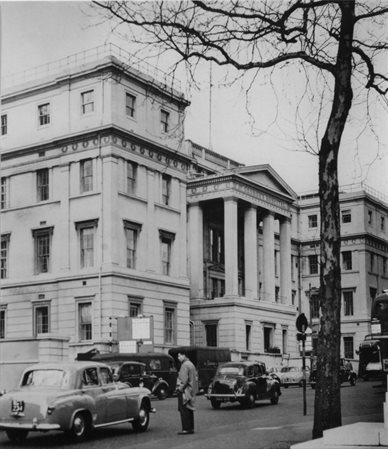
This hospital has a history dating back 200 years, many of the buildings and wards have been named after famous physicians and patients.
The original Set. George’s Hospital opened at Hyde Park Corner as a 60 bed hospital in 1733.
In 1820 it was rebuilt as a 300 bed hospital but less than 30 years later it ws struggling to cope with a grown ng population in London. A new hospital was built in Wimbledon for convalescing to cope with the extra demand and a medical school was established on the site of St. Georges Hospital in 1868.
To coincide with the growing suburban population of London it was decided to move St. George’s Hospital and the medical school. In 1976 the medical school now known as St. George’s University moved to Tooting followed by the St. George’s Hospital as the Hyde Park Hospital closed in 1980, it is now a Hotel named after Lanesborough House from the original hospital.
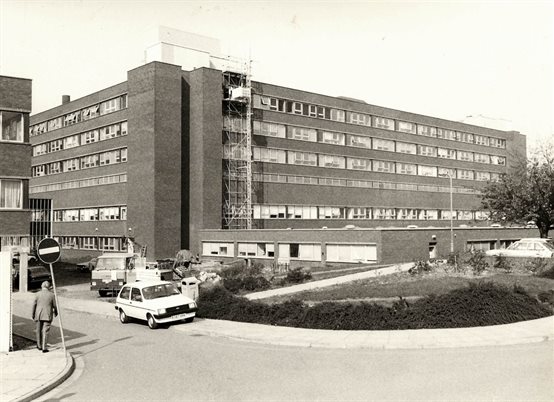
St. George’s in Tooting now has 1300 beds and is a major London Hospital with centres of excellence which include a cardiology centre and a stroke centre.
In 1984 a new Jenner wing opened. In 1988 following the closure of St. James Hospital in Balham the new St. James wing opened. The St. George’s Healthcare NHS trust took over from the St. George’s group in 1993.
In 2003 the Atkinson Morley Hospital (the original convalescent home in Wimbledon) closed all services were moved to the Atkinson Morley Wing in Tooting.
In 2010 St. George’s healthcare became one of eight hyper-acute stroke units and one of four major trauma centres in London, community services Wandsworth were merged with St. George’s which then became responsible for services based in Health Centres, GP practices, HMP Wandsworth, nurseries and schools and Queen Mary’s Hospital in Roehampton. In 2012 services at The Wolson Neurorehabilitation centre moved to St. Mary’s Roehampton and St. George’s Tooting when the centre in Wimbledon closed. In 2013 work started on the new Helipad above St. James wing and the redeveloped emergency department opened.
Source: https://www.stgeorges.nhs.uk/about/history/st-georges-hospital/#:~:text=St George's Hospital in Tooting,what was then open countryside.
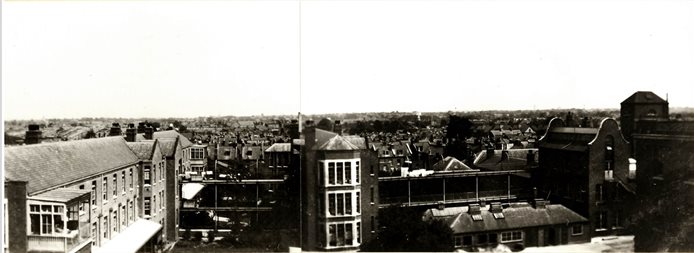
I was referred there when I was a child as I had what is commonly called a lazy eye, I always remember having to look into a machine where I could see images of a Policeman and a sentry box, I was told to put the Policeman in the box. I did this thinking I had managed it alright but because of my lazy left eye it wasn’t where I thought it was. To this day I still have my lazy left eye as it was too late to correct it by the time the school optician examined my eyes.
I can’t remember much about the building, I know it seemed to be a modern building but looking at some of the photographs online, it looks really nice, more like a hotel lounge than a hospital waiting room.
In the 1890s there was a rapid population growth with a need for more poor relief. The Wandsworth Union purchased the site of the St. James’s Road Industrial School for the sum of £21,000 from the Westminster Union. Originally the school was build in 1851 to house juvenile offenders, when the buildings were converted it became known as the St. James’s Road branch of the Garratt Lane workhouse. The workhouse gardens in Sarsfield Road were used to build the St. James’ infirmary.
The official opening took place in November 1910, the ceremony took place in an unfurnished ward led by the Rt Hon John Burns who was president of the Local Government Board. The building could accommodate 606 patients and cost £66,550. There was an administration block two storeys high which had a long corridor either side which linked it to the 3 storey ward blocks, the south side for men and the north side for women, the infirmary was in St. James’s Road it was housed in the old workhouse building.
The hospital was used in the first world war as an auxiliary military hospital to the First London General Hospital, it had 68 beds that were allocated to wounded or sick servicemen.
The name was changed to St. James’s Hospital in 1920, by then there were 670 beds. A new nurses home was added when staff accommodation was improved on 1923, that could accommodate 155 members of staff and a further nurses home as build in 1926 in the southern part of the site.
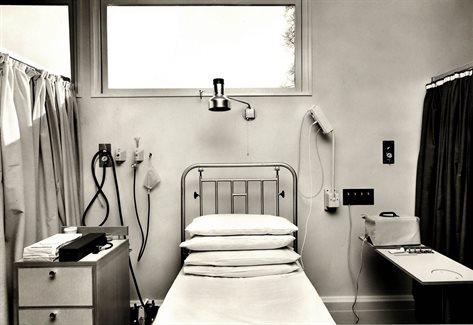
The London County Council took control of this hospital in 1930, it then became a general hospital with 746 beds. The hospital was expanded greatly between the years of 1931 and 1936, two blocks were added that had six extra wards increasing the number of beds to 898. In 1935 physiotherapy and x-ray departments were built and in 1936 an extension to the Nurses’ home provided lecture training rooms in the nurses training school which also gave more accommodation for a further 44 nurses.
The hospital suffered superficial damage from incendiary bombs during the second world war with over 200 falling on the site on just one occasion. A flying bomb damaged three wards in 1944, it also damaged the boiler room and the laundry and the opposite side of the hospital was damaged when a second flying bomb fell outside the gates soon after.
In July 1948 it joined the NHS under the control of Wandsworth Group Hospital Management Committee with 610 beds, this was part of the South West Metropolitan Regional Hospital Board and by 1948 there were 628 beds available.
637 beds by 1949 and 642 beds by 1950. On St. James’s drive a new entrance for the hospital was built as land had been acquired in Sarsfield Road and St. James’s Road (which became St. James’s Drive).
The hospital had originally been designed for the treatment of out-patients and that was housed in the former casualty department which was a small obsolete building as well as the x-ray department, dispensary and pathology laboratory. In 1951 a decision was made to replace the old workhouse building with anew central complex which contained the out-patients department, Admissions and Accident and Emergency department, above were dining rooms and to the north Physiotherapy and x-ray departments and to the South a nurses home.
In 1952 Frank H. Elliott laid the foundation stone, he was the Chairman of the South West, the building works began but in post war years there was little steel available so the building was redesigned to accommodate this problem. Prestressed concrete was used, it incorporated wire instead of rods for the metal reinforcements, patients were moved to The Grove Hospital in Tooting and St. Benedicts Hospital in Tooting while this work was carried out.
At the end of building the hospital had 1082 beds, in 1974 after a major reorganisation of the NHS, it came under the Wandsworth and East Merton District Health Authority which was part of the South West Thames Regional Health Authority.
St. George’s Hospital in Tooting amalgamated with St. James’s Hospital 1980, sadly the hospital was closed in 1988 when St. James’s wing was added to St. Georges Hospital in Tooting.
My interest in this hospital is because my brother was born there in 1950, my poor mum had to get there on a tram from Tooting as there was no ambulance or car to take her when she was in labour, I was born there in 1952.
This was an asylum established by the Metropolitan Asylums Board, there were three other asylums at Darenth, Caterham and Leavesden, this fourth asylum in Tooting Bec was to relieve overcrowding.
The site was part of the Tooting Lodge estate and was 28 acres big. It was purchased for £27,000 in 1894, the construction work commenced in 1899. The design was the same as Chatham and Leavesden asylums with a central administration building with two rows of blocks on either side.
This hospital was opened in 1902 although the first 250 patients were admitted in 1903, there were 1000 beds, it cost just over £20,000 to build and was based on the block system.
The three floors of wards had 24 beds on each ward on each floor, the wards had Taunton Diagonal bedsteads, the ones allocated to epileptic patients were only 8 inches from the floor, there were double fireplaces in each ward.
There were only seven ward blocks built although nine were planned, there were only four for female patients instead of five, and only three for males instead of four. Long walkways connected each block, although these walkways had a roof they did not have closed in sides, the first and second floor of each ward block was connected to its neighbour by a fire escape which served as airing courts or promenade decks for the patients or if the patient was bedridden it served as a verandah in fine weather.
The central block had staff rooms and contained offices, at the rear was a single storey section that contained a laundry, quarters for domestic staff, storerooms, a boiler house, the gas works and dynamo house, two three storey nurses homes were sited to the north.
The use of the asylum was designated to patients with senile dementia, infirm epileptics and patients that required exceptional individual attention. This site was chosen specifically because it was less remote and family and friends could visit elderly patients easily.
There was no patient labour at this hospital unlike other mental hospitals at that time, every five patients had one nurse to care for them.
Following a serious fire at Colney Hatch Asylum in February, patients from there had to be housed in Tooting Bec although that was not the original plan to house overcrowded asylums in three other locations.
Two ward blocks not built originally in 1902 were added to the site in 1906 as well as a hall for recreation which doubled as a chapel this was built between domestic staff quarters and the laundry.
On the eastern side of the site a further block was built, this was a receiving home for children, it had five single storey blocks and a central two storey administration block.
Just before the outbreak of world war one in 1914, the metropolitan asylum board decided to double the amounts of bed accommodation to 2200. They expanded the asylum by buying Bushey Down House a large mansion that was south west of the asylum, the building work stopped in 1916 due to the war and commended again in 1919.
The first part of the extension was finished in 1924, there were four villas for female patients, these contained two wards of 30 beds on each floor. There were also 32 single rooms. This new block also had verandahs that were on the ground floor, on the upper floors were fire escape bridges.
The recreation hall and dining hall were extended and a nurses home for 112 nurses was also built, in this same year the hospital was given the new name of Tooting Bec Mental Hospital.
In 1925 the building work for the three storey pavilions to house male patients was completed, each pavilion contained a 36 bed ward on each floor, by then the hospital had 2200 beds and it was used exclusively to house patients suffering with dementia.
The London County Council took control in 1930, further extensions were built and the hospital was renamed again in 1937 to Tooting Bec Hospital, the word mental was dropped from the title. By 1939 there were 2355 beds. In 1948 the National Health Service took over so it was controlled by the Tooting Bec Hospital Management Committee. It was part of the South West Metropolitan Regional Hospital Board. Following a major reorganisation of the NHS in 1974, administration of the hospital was taken over by the St. Thomas’ (Teaching) District Health Authority, this was part of the South East Thames Regional Health Authority. After yet another reorganisation of the NHS in 1982, the West Lambeth District Health Authority took over authority. In the 1970s there was a decline in the use of the hospital and in 1989 the site was put up for sale. It finally closed in 1995 and all services were transferred to St. Thomas’ Hospital.
The hospital was demolished between 1996 and 1997, Fairview Homed redeveloped the site and it residential. The name of the new residential site is Heritage Park, it is a housing estate with approximately 600 dwellings, the cost of building the new estate was £42 million. There is also a medical practice on the new site with nursing home in Church Lane. There remains 20 meters of the original wall at the Northwest corner as well as an original willow tree.
Source: https://ezitis.myzen.co.uk/tootingbec.html
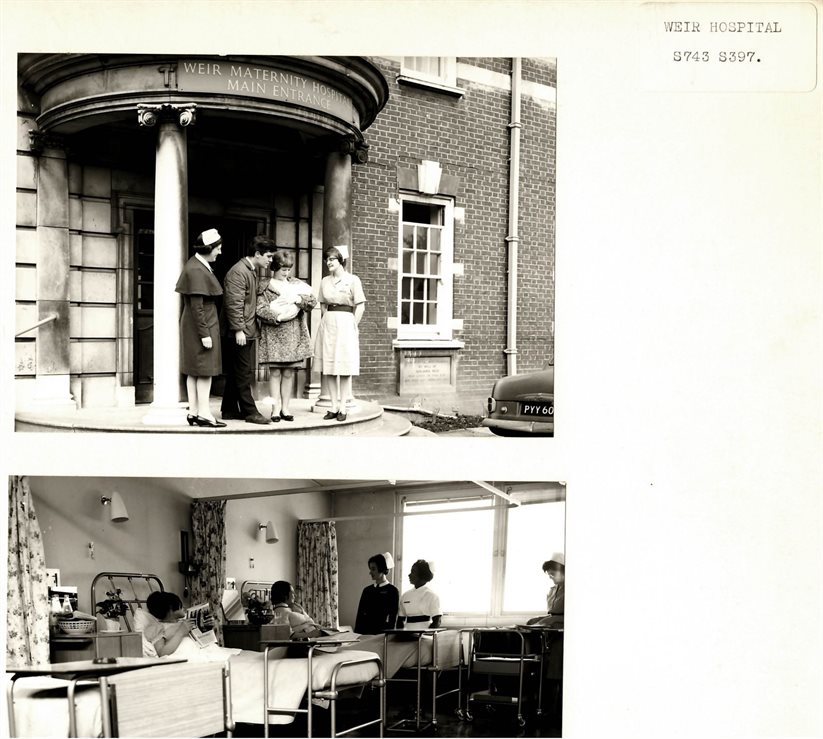
Benjamin Weir died in February 1902 and this hospital was founded under the provision of his will. In December 1911 the hospital opened in Grove Road in Balham, it took a time to establish the hospital due to controversy over the manner in which the provisions of the will should be carried out as well as restrictive covenants. Also part of the Weir request was a dispensary, this had been opened at 22 Old Devonshire Road during the time of this long interim period. The Hawthorns was the home of the late benefactor and it occupied part of the hospital site, an adjoining property had been purchased with monies from the Weir Trust.
The Kensington Division of the Red Cross were searching for its borough for a suitable property when war broke out in 1914 to establish a hospital but was unable to find one. The trustees of the Weir Hospital divided its hospital buildings and offered them free of rent. This remained the case for the whole duration of the war.
During WW1 on 17th November 1914, the Kensington Division of the red cross took over the hospital. It became a section of the Third London (T. F.) General Hospital and was known as the Kensington Red Cross War Hospital.It had an excellent operating theatre, this was thanks to an anonymous donor and Mrs Whitaker Thompson, it also had modern X-Ray apparatus and with every facility was one of the most up to date hospitals.
The staff consisted of 23 full-time members of a voluntary aid detachment and 4 trained nurses initially, patients were received from the Third London General Hospital and soon after directly from the front, from the war theatres in Mesopotamia and France. It became one of four hospitals that were receiving patients directly from abroad instead of the usually way of via a military hospital. The three other hospitals receiving patients directly were 27 Berkeley Square, Gerstley-Hoare Hospital for Officers and 24 Park Street.
It began with 36 beds, this soon proved to be inadequate so a house for staff quarters was obtained rent free. This released space to allow more beds so by the end of December 1914 there were 50 beds occupied in the hospital. Another ward became available in the Autumn of 1915, there were 100 beds in the hospital after 10 months of opening. To provide a hospital chapel, a special fund was raised in the Autumn, it was a hutted building and it opened on 26th November 1915 which was the first anniversary of opening the War Hospital. It was dedicated to St. Michael and all angles. It was officiated by the Vicar of Kensington and the Bishop of Kensington.
To defray running expenses some £2,300 was raised between December 1915 and February 1916.
Princess Louise opened a new ward with 60 beds in April 1916, this was staffed by 5 part-time and 50 full-time members of the Voluntary Aid Detachment these people did much of the nursing, the housework and all the cooking, there were also10 trained nurses. On 30th June 1919 the military hospital closed, it had by that time treated 4,535 wounded men, a lot were serious cases and only 5 died.
It became a general hospital again in 1920 with an out-patient department and 30 beds.
Wandsworth Borough Council built a new Maternity hospital in 1931, it was called the Wandsworth War Memorial Maternity Home. It was built on a site adjacent to the Weir Hospital it had an isolation ward with 2 beds, 20 ordinary beds and replaced the hospital on Park Hill. It was administered by The Weir Hospital until 1934 when the Council took over. Grove Road became Weir Road in 1936.
The NHS took over the hospital in 1948 and as the hospital only had 30 beds the Regional Board considered it was uneconomical for it to continue to be run as a general hospital dealing with all specialties, it was decided it should become a specialised unit. The decision was to combine the Wandsworth War Memorial Maternity Home with the Weir hospital as both properties were adjoining.
There was dismay in the local population upon closing the Weir Hospital because of the high standard of service when it was a general hospital. There was no hesitation when the Regional Board made the decision it was accepted by the Hospital Management Committee. The ground floor of the hospital housed the administrative offices of the Wandsworth Hospital Group.
On 31st May 1950 The Weir Hospital was closed, after redecoration and alterations it went from a general hospital to a Maternity Hospital with 50 beds reopening on 21st August 1950 combining both hospitals to The War Memorial Maternity Hospital.
A premature baby unit was opened in 1951 after closing the St. James’ Hospital unit, it was housed in a separate wing and had 12 cots. Now The Weir Hospital had 63 beds, also in that year a fire alarm system was installed as well as the hospital being completely rewired. The resident nursing staff had new bedspreads and new carpets paid for by The Weir Trust. A new chest clinic was installed in the rear of the building after it was adapted, this replaced the one shared with the LCC Child Welfare Clinic at 91 Bedford Hill. It was considered an unsatisfactory arrangement. There was a new maternity unit built at a cost of £42,000 during 1965 and 1966. After the government dictated that Maternity units should be located in General hospitals, the hospital finally closed in 1977.
The hospital has now been demolished, only the 1931 maternity home building remains. The Metropolitan Housing Trust redeveloped the site in 1987, it is now a housing estate - Molly Huggins Close.
Source: https://ezitis.myzen.co.uk/weir.html